Disclaimer: As an Amazon Associate I earn from qualifying purchases. Therefore, we may collect a share of sales from the links on this page, at no extra cost to you!
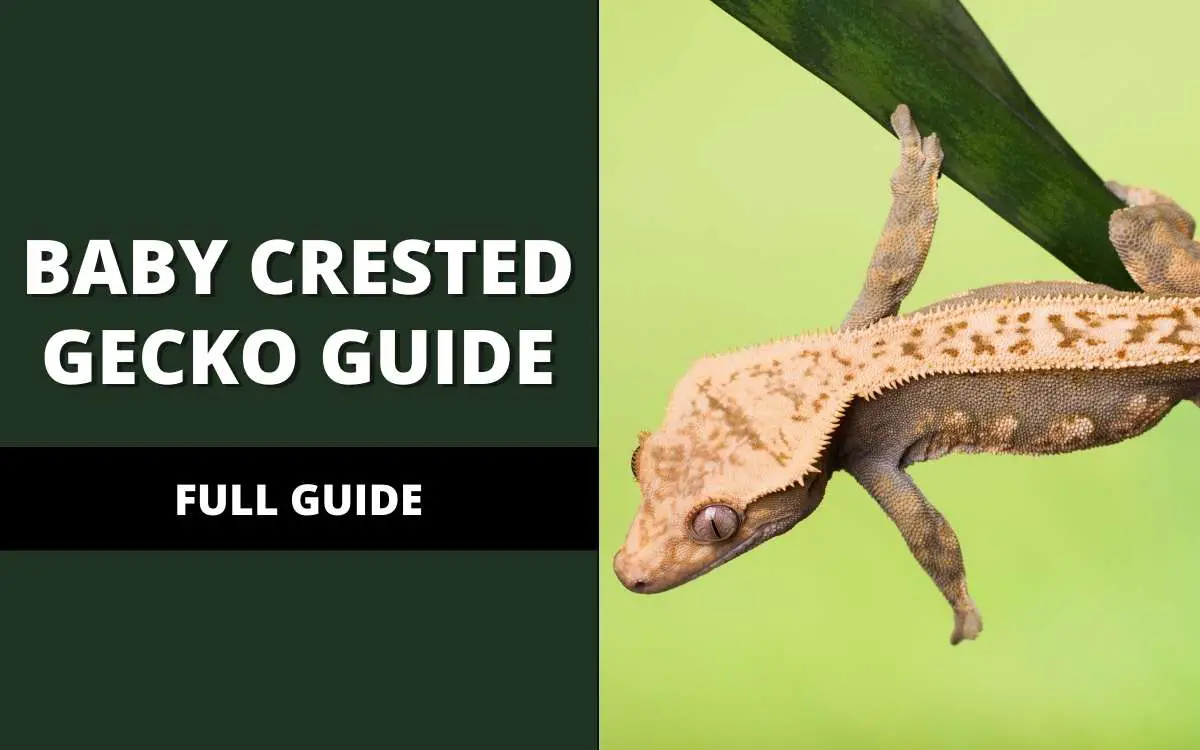
Baby Crested Gecko Care
Whether you’re getting a baby crested gecko from the pet store or your adult gecko’s eggs just hatched, taking care of such a tiny little gecko can feel a bit daunting!
And if it is your first time with such a young reptile, you’re probably second-guessing your every move.
So, how do you take care of a baby crested gecko?
You will be relieved to learn that caring for baby and juvenile crested geckos is very similar to caring for adults, albeit with a few changes here and there.
However, don’t worry – we’re here to help! This article will cover taking care of both hatchlings and juvenile crested geckos up to 6 months old.
Throughout this article, we’re going to cover everything from costs, diet, enclosure, handling, and more! Keep reading to learn more!
Jump to..
How Much is a Crested Gecko? What About Supplies?
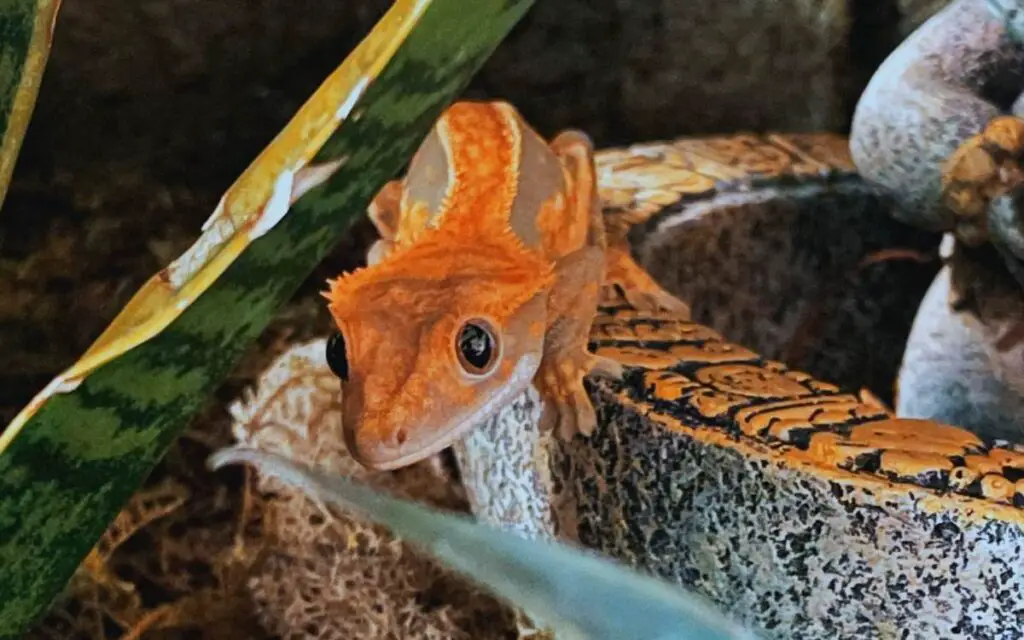
If you’re like me, the first thing on your mind is probably cost. Of course, if you already own a crested gecko, you can move onto the next section. However, if you haven’t already gotten your baby crested gecko, you’re going to want to gather everything you need beforehand.
So, what is the total up-front cost of purchasing everything you need for a crested gecko?
Well, there’s a few factors that come into play. One of the biggest factors is where you decide to shop. If you go to a pet store such as Petsmart or Petco, you’re going to end up spending a lot more than you would if you buy everything online.
I personally shop on Amazon for all of my reptile supplies. Therefore, here’s a rough breakdown of the costs associated with buying a crested gecko:
- Tank/enclosure – $150 (See my recommendation)
- Artificial plants – $10 (See my recommendation)
- Artificial vines – $10 (See my recommendation)
- Substrate – $15 (See my recommendation)
- Food/water dish – $15 (See my recommendation)
- Temperature gauge – $10 (See my recommendation)
- Spray bottle – $5 (See my recommendation)
- Food – $20 (See my recommendation)
Feeding a Baby Crested Gecko
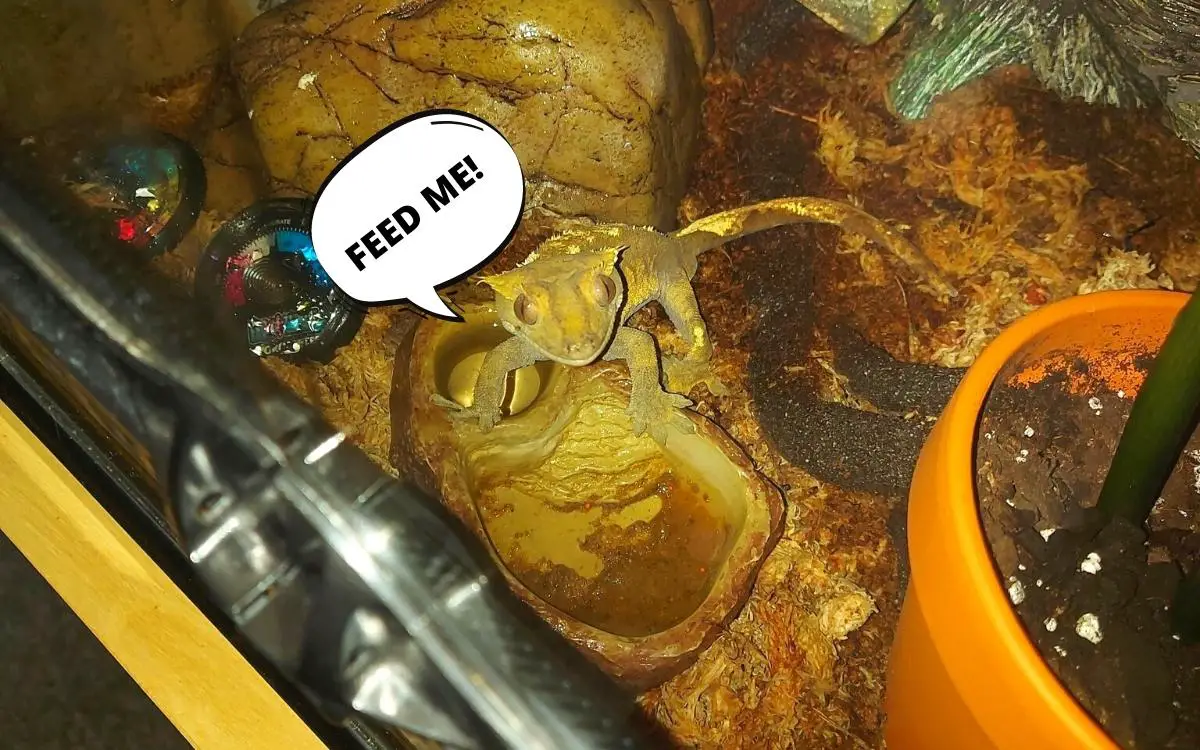
Once you get a hatchling or juvenile gecko, your biggest concern will probably be feeding them. What do they eat? How often do they eat? What nutrients do they need?
Well, don’t worry. Providing for them is not as complicated as it may seem. In fact, it’s just a slight modification to what you would feed to an adult crested gecko.
Hatchlings
Because the energy of their yolk sacs can sustain hatchlings for some time, they usually don’t eat for a couple of days after hatching. However, you should provide some food a day or two after hatching just in case they feel hungry.
Dietary needs
While crested geckos are omnivores and can eat both plant and animal-sustained diets, you will want to strictly feed your baby crested gecko commercial gecko food.
This is basically a powdered substance that you mix with water. Here is an example of what it looks like:
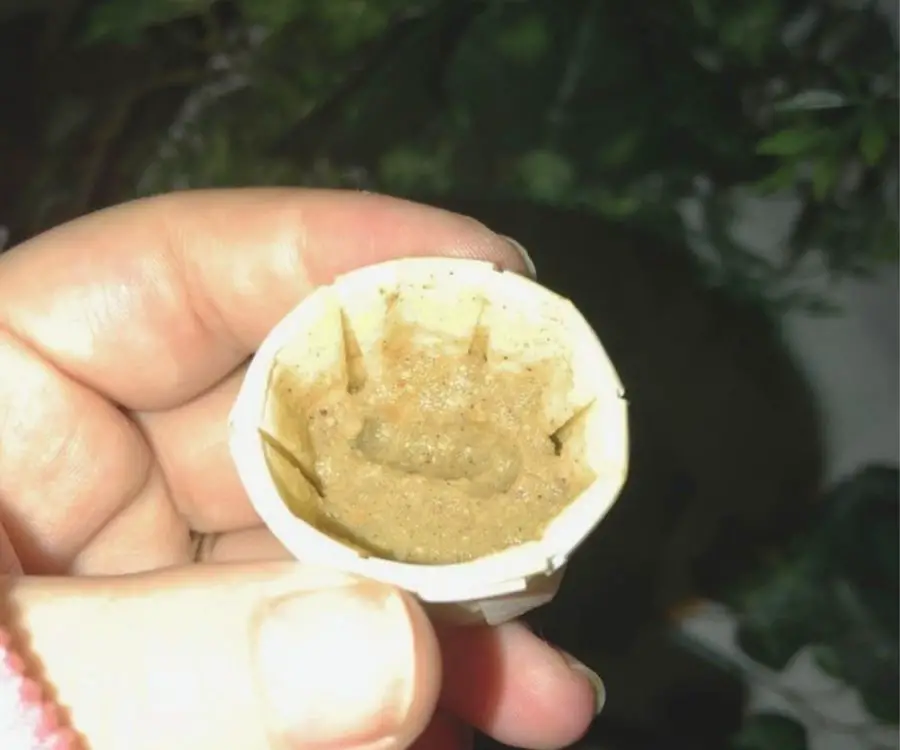
The reason why it’s so crucial for baby crested geckos is because they have very demanding nutritional needs that live bugs and fruits simply can’t meet.
We personally use Pangea Fruit Mix Fig & Insect Diet for our baby crested geckos as it tastes delicious and contains all the essential nutrients for your crestie to grow healthy and strong.
You can find it on Amazon here:
Preparing the commercial gecko diet is very simple: It’s 1 part powder to 2 parts water. You can put the food in a small ceramic bowl or disposable cup. I personally use disposable cups so I don’t have to clean out a ceramic bowl each time I feed my crested geckos.
When your baby crested gecko is around a month old, you can start introducing gut loaded insects dusted with calcium and D3 powder. A crestie’s favorite is crickets, but make sure they’re small enough for your baby gecko to eat comfortably.
However, if you don’t want to feed your crested gecko any live insects, they can survive on commercial crested gecko diet alone.
Pro tip: Make sure any bug you decide to feed your crested gecko is smaller than their head!
You can also include a treat like mashed fruit, but these should be kept at a minimum.
Such delicious treats may make for an excellent way to win over your reptile, but they don’t really provide the nutrients a baby crested gecko needs to grow.
We advise you to feed mashed fruit to your baby gecko once or twice a month.
Water
In the wild, baby crested geckos usually drink droplets of water from the dew. However, since it’s difficult to recreate this in an enclosure, place a small bowl of water inside the enclosure instead. Ensure that the bowl is shallow to protect your reptile from drowning and change the water daily.
Housing a Baby Crested Gecko
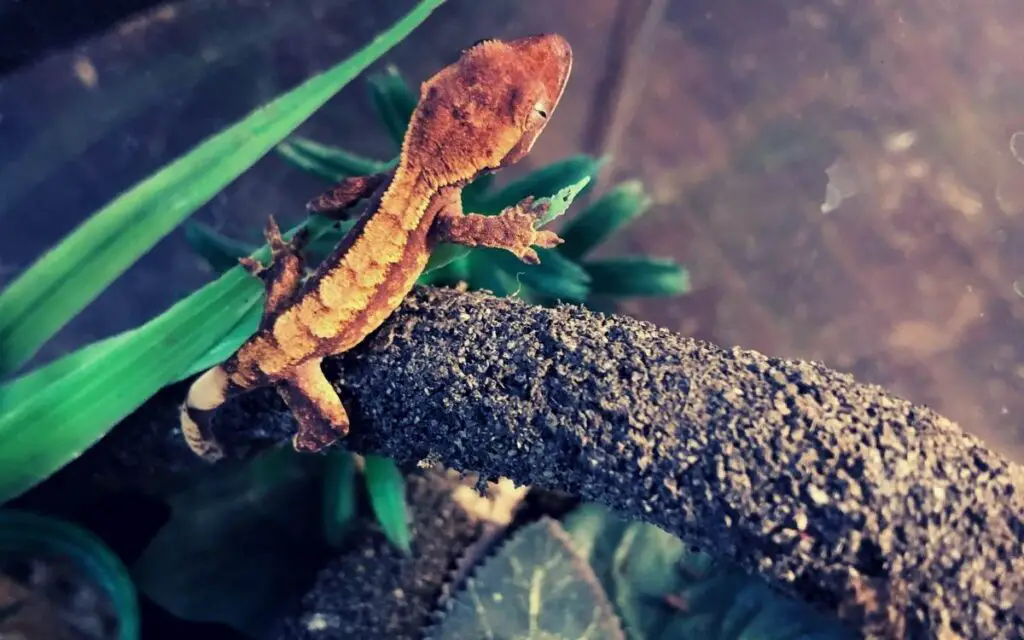
Enclosure
Fortunately, crested geckos don’t require large enclosures like other reptiles such as the bearded dragon. A 5-10 gallon tank should be plenty of space for a juvenile crested gecko. For adult geckos, you’ll want to upgrade to a 20-gallon enclosure.
Crested geckos are arboreal (meaning they love to climb), so a tall enclosure is your best option. The Exo-Terra 12 x 12 x 18 Inches Reptile Enclosure is the tank we use for both our baby and adult crested geckos and it works perfectly.
The ideal tank for a crested gecko should have the following characteristics:
- Tall, rather than wide
- Plenty of ventilation (screen top)
- Lots of space for climbing and other activities (10-20 gallons)
- Escape-proof
To give you a better idea on the size/layout of a crested gecko tank, here’s a picture of our crested gecko’s enclosure:
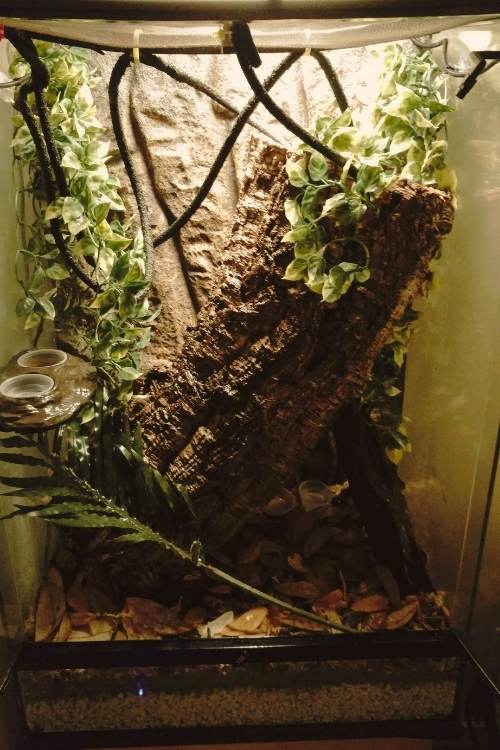
Substrate
Due to their small size, you will also have to be careful about the substrate type you use in your reptile’s enclosure. It should be hard to ingest while being easy to clean. You don’t want anything soft enough for them to bite off and swallow or small enough to be devoured in one bite. Therefore, things like soil, coco fiber, and tree bark should be avoided.
In your quest to completely eliminate the risk of ingestion, you may be tempted to use no substrate at all. But this comes with some risks and added responsibility. The high humidity in the enclosure will condense on the terrarium’s surface, and water will build up, making for an uncomfortable existence for your juvenile gecko. There is also an added risk of bacteria buildup, and you will have to clean the enclosure daily.
Paper substrates are great for baby crested geckos under 15 grams. Many people use old newspapers or paper towels as the first substrate for their juvenile reptiles. These provide an excellent surface for your baby crested gecko, and they’re not easy to bite off, hence reducing the risk of ingestion. If you need a more robust paper substrate just in case your crestie can tear through paper towels; butcher paper is an excellent alternative. For hygienic purposes, remember to replace the paper substrate every week.
Temperature and Humidity
Just like with the adults, baby crested geckos require a temperature specific environment. To thrive, your baby crestie will need temperatures between 70 and 80 degrees during the day and 69 and 74 degrees Fahrenheit at night.
Therefore, you won’t need any heating bulbs for your crestie. Typically, they thrive in room temperature environments. However, anything warmer than 80 degrees can result in heatstroke or other health issues for your gecko.
On the other hand, crested geckos do require vitamin D3. This is essential for the development of your crestie.
This can be acquired in two ways. Your first option is to dust your crested gecko’s insects with calcium powder. Alternatively, you can purchase a UVB bulb that will rest on the roof of your enclosure.
Personally, I prefer using a UVB bulb since it requires less work and you don’t have to worry about giving your crested gecko the proper amount of calcium powder that they need. However, this is entirely up to you.
If you are interested in purchasing a UVB bulb, we have a detailed lighting guide that includes all the best bulbs on the market.
Additionally, crested geckos also require relatively high levels of humidity, usually between 50% and 80%. Their small size and high surface area to volume ratio also means that baby crested geckos quickly dehydrate. Hence, keeping a shallow water bowl and regularly misting the tank should help regulate the humidity and reduce dehydration.
Terrarium plants and branches
Plants and branches are a useful feature in a terrarium. They give the enclosure an attractive, natural look, increase the humidity, provide a way for the crested gecko to explore their home, and form a cool hiding place.
But since baby cresties live in small enclosures, adding live plants is probably not a great idea. This is because the plants will take up a lot of space as they grow, which may cause your crestie to feel suffocated. As a result, you may end up having to change terrariums a couple of times, and trust me, moving live plants from one enclosure to another can be very difficult.
Therefore, you can use fake vines and plants in lieu of live ones. These fake plants may not be perfect, but they serve their purpose well while being easy to manage. You can combine the fake vines with a couple of branches to give your enclosure a more natural feel.
How to Handle a Baby Crested Gecko
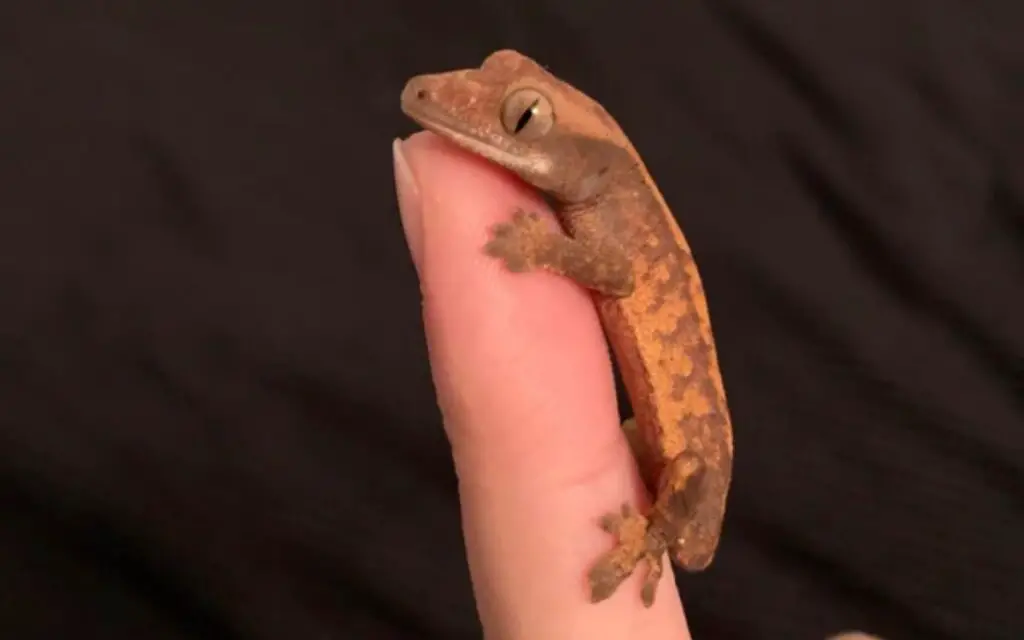
The size of a crested gecko will determine how you should handle them. A freshly hatched baby crested gecko is tiny, weighing a meager 2 grams and measuring 2.5 to 3 inches in length. Therefore, when handling a baby crested gecko, you need to be extremely cautious. Squeezing, grabbing, or dropping them can result in injury or even death.
When handling your baby crested gecko, you’ll quickly realize these guys are extremely fast. Their speed will make it challenging to handle them. This is because they are yet to get used to getting held, and you’ll notice this when they wriggle away and probably jump out of your hands every time you try to handle them.
It can be pretty risky when they behave this way. For instance, they may jump off, fall on a hard surface, and hurt themselves in the process, which is why you should limit handling them to the minimum frequency possible. Only do it when it is necessary, like when it’s time to weigh and measure. Even then, exercise caution and never grab your crested gecko by the tail if you don’t want to stress them and cause tail loss.
You can also still fulfill your terrarium cleaning duties, but try to do so without disturbing the gecko. You will gradually learn how to handle your crested gecko as they grow and your relationship will grow stronger as they grow older.
Here are other useful tips on handling your baby crested gecko:
- Replace the food and water when your crestie is asleep to reduce stress.
- When cleaning the enclosure, put your gecko on a branch rather than handling them the whole time.
- Before handling your baby crestie, create a calm atmosphere by eliminating any noises likely to startle them. Reduce the TV’s volume and ask your kids (if any) to keep calm and stop running around. This will make them less alert and less likely to run and jump around.
- The hand walking technique is an excellent first step to handling your cresties. You basically allow your gecko to move as they please along your arms. Do this for one or two minutes every day when they are around three months old and gradually increase the hand walking time to as long as 15 minutes.
Health
As you raise your baby crested geckos, there are a couple of health issues you should pay close attention to, with the most common being shedding. Hatchlings shed at a much faster rate than adults (once every week), making them more susceptible to stuck shed and dehydration. If left unchecked, stuck shed constricts blood flow to the affected part of the body, which leads to discomfort, injury, and even amputation. Thus, you should watch out for signs of unshed skin around the toes and tail area every week.
Taming a Baby Crested Gecko
All pet owners naturally want to tame and create a bond with their animals. For baby cresties under three months, this can be quite challenging as they are still trying to figure out their environment. Therefore, you need to be patient and take things slow and easy.
Before making any serious attempts to bond with your gecko, give them enough time to get used to your presence and their new home. Your crestie may not have the best of eyesight, but they have a relatively good sense of smell. Therefore, they will eventually learn to recognize your presence by your scent and associate it with good things like food. As your young crestie gets used to you, you can try to strengthen this bond by feeding them from your hand.
Frequently Asked Questions About Baby Crested Geckos
How often do baby crested geckos eat?
Since they are growing at a much faster rate, baby crested geckos eat more often than adults. They don’t really need to eat every day, but you should feed them four to five times a week.
Can you house baby crested geckos together?
Baby crested geckos are small, so you can fit a couple in a normal-sized terrarium. However, you should separate them once they reach six months since they will be too large to fit in one.
Do baby crested geckos bite?
When a crested baby gecko doesn’t want to be handled, they may bite. Don’t worry though; it won’t hurt or cause any serious injury.
Can a baby crested gecko drink tap water?
Unless the water is contaminated, drinking tap water is perfectly fine for your crested gecko. Some people raise concerns over the chlorine present in tap water, but this hasn’t been proven to cause any harm to a crestie.
Summary
For many people, rearing baby cresties for the first time is accompanied by a lot of uncertainty. Still, with our guide, you will successfully raise your small and fragile hatchling into happy, healthy adults. All you need to do is provide proper housing, handle them with care, and feed them a nutritious diet. Good luck!
